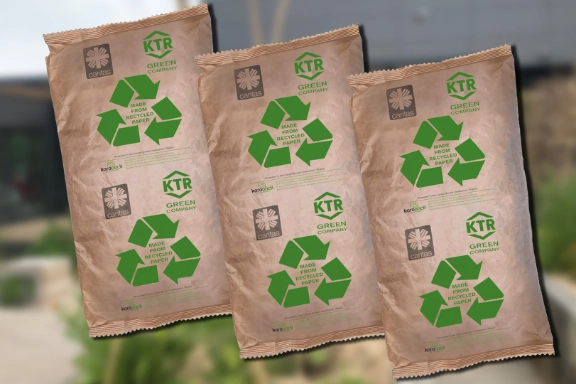Sustainble paper recycling concept: a clear win-win situation
Sustainbility
KTR implements sustainable paper recycling concept with Caritas: Interview with the initiators Stefan Greve (Caritas) and Benedikt Bußmann (KTR).
At KTR's headquarters in Rheine 106 tons of paper waste are produced every year which have to be disposed of properly. At the same time, about 80 tons of packaging material are being used at the site. All in all, this has so far resulted in costs in the five-digit range.

But from December 2020, everything will be different
A new recycling concept developed together with KTR's long-term cooperation partner Caritas will install a sustainable recycling circuit in Rheine. In an interview Stefan Greve, production manager of the Caritas-Emstor workshops, and Benedikt Bußmann, head of logistics at KTR, explain how the concept was developed and what advantages it offers.
Mr. Bußmann, when did you first think: we have to find a new, resource-saving solution for paper and packaging?
Benedikt Bußmann: When we optimized our packaging standards, we automatically addressed the issues of sustainability and environmental protection. It quickly became clear to us that there are better and more ecological solutions than our previous ones. Our current standard already provides for the use of exclusively recycled material. But the Karopack system is the logical next step for us now - and we are very pleased to be working together again with the Caritas-Emstor workshops in the area of environmental protection.
How did this collaboration come about?
Benedikt Bußmann: The recycling company Karopack encouraged the cooperation with workshops for disabled people for our sustainable paper concept. It was clear to us that we would expand our cooperation with our proven partner Caritas if possible. After all, KTR has been working together with Caritas-Emstor-Werkstätten Rheine for a long time and with great success.
How exactly does the new recycling cycle work - and who is responsible for which tasks?
Benedikt Bußmann: At KTR we collect all paper and cardboard waste from all departments and put it into special collection boxes for recycling. We use the daily trips between the Caritas-Emstor workshops and KTR for both disposal and supply. Thus, the utilization of the trucks used is also always ensured and we avoid empty runs. In short: For KTR everything actually works as before - but now we get the recycled waste back in the form of upholstery. And we can do without our previous disposal station and containers.
Stefan Greve: We also collect our old cardboard boxes in the Caritas-Emstor workshops and feed them into the new recycling cycle that we have started with this cooperation. We have further optimized our existing logistics for this purpose. With the aim that the implementation of this project will not require any additional truck tours, but will ensure that these are optimally exploited in the future.
And how does the paper recycling process actually work?
Stefan Greve: In the first step, a uniform and usable raw material chip is produced from the old cardboard box, which is undefined in size, shape and weight. This chip is the basis for further processing and use. In the next step, this raw material is dosed and fed into a wrapper, which creates the final product. This project requires a certain degree of automation in order to be able to reproduce both quality and quantity. Basically, we strive to create attractive jobs with which our employees can identify.
Mr. Greve, you are purchasing a new machine especially for the implementation of the concept. What exactly does it do - and what role does it play in the recycling concept?
Stefan Greve: The heart of the machine is a "filling-sealing unit", which is preceded by several shredding machines. These individual components are interdependent, which is why we can set up more than one workplace on the machine. The machine supports our employees in the production process by mechanically producing the chips, dosing them in the desired quantity and filling them into a bag.
Was there already a test run?
Stefan Greve: We discussed the project intensively with the Karopack company in advance because we wanted to implement slight deviations from the actual Karopack system. Karopack was very open to this and saw very interesting aspects in it that could be transferred to other projects. This created a clear win-win situation. The project began with a visit to a machine that was active in the market in order to be able to generally check whether all this could be integrated in the Caritas Emstor workshops. In the further course, the planned deviations were individually examined, tested and then integrated into the actual Karopack system. We rate the result as positive in every respect - the concept has fully proven itself not only in theory, but also in practice.
Mr. Bußmann, how high are the savings you expect to achieve in the disposal and consumption of paper in Rheine?
Benedikt Bußmann: At the moment, we cannot exactly quantify the total amount of savings. But we are already making five-digit savings on disposal costs.
What changes and simplifications in work processes result from the new concept?
Stefan Greve: We see great potential in the value-added chain in the handling of the raw material cardboard. Furthermore, the concept enables us to create attractive jobs for people with disabilities.
In which other areas do the Caritas Emstor workshops cooperate with KTR?
Stefan Greve: We have already implemented a number of interesting tasks together, for example in the areas of green space maintenance, assembly and pressing tasks, or even for putting together sets or packaging jobs.
Benedikt Bußmann: Our many joint projects are going well - and we are always open to new areas of cooperation.




